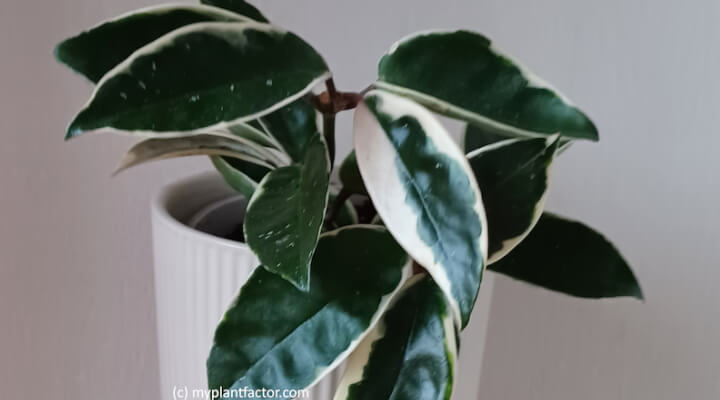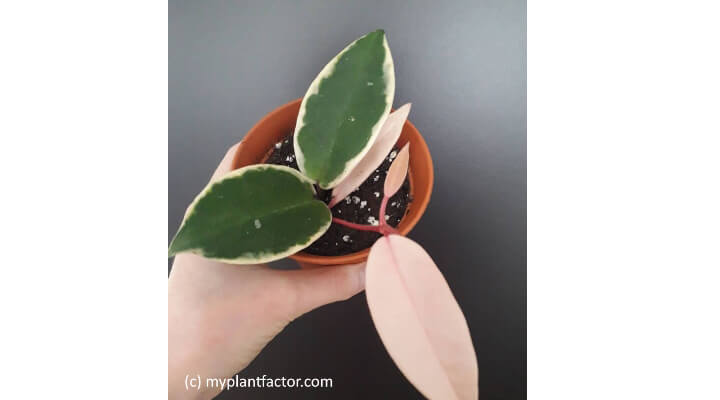
Hoya Krimson Queen: Hoya Carnosa Care Guide and Identification

The Hoya Krimson Queen is a type of wax plant from the popular Hoya variety Hoya carnosa. The Hoya plant is identified by its thick, waxy, lance-shaped leaves growing on long, trailing vines. The color variegation of its leaves is pink, creamy white, and green. This attractive variegated hoya plant is called Hoya Tricolor or Hoya Carnosa Variegata.
The Hoya carnosa ‘Krimson Queen’ is relatively easy to care for indoors. The popular tropical houseplant requires growing in a location with bright light but protected from sunlight. It requires occasional watering; however, it has high humidity requirements.
This article is a comprehensive guide on growing the Hoya carnosa ‘Krimson Queen’ indoors. It also includes an informative hoya plant care guide and information on resolving common issues you may encounter while growing this variegated hoya plant in your houseplant collection.
For Hoya carnosa care to propagation, this article has you covered.
What Is Hoya Carnosa Krimson Queen?
The Hoya Krimson Queen is a popular variegated wax plant with lance-shaped leaves featuring creamy-white edges and pinkish hues. It’s a cultivar of the Hoya carnosa species of Hoya plant. The wax plant is known for its trailing vines and waxy texture. It blooms with clusters of star-shaped flowers.
Hoya plants are perennial evergreen plants belonging to the genus Hoya and the family Apocynaceae. Hoya carnosa varieties are known for their long trailing vines. The variegated leaves on the ‘Queen’ are green with white and pink patches.
Other names for Hoya carnosa ‘Krimson Queen’ are Hoya ‘Variegata’ and Hoya ‘Tricolor.’
Native to Southeast Asia, Hoya ‘Krimson Queen’ is an epiphytic plant, meaning it grows on tree trunks or branches for support instead of soil. Therefore, growing Hoya ‘Tricolor’ in hanging baskets as trailing plants is best. These plants also have semi-succulent traits, which help them survive long periods of lesser and infrequent watering.
Hoya Carnosa ‘Krimson Queen’ Facts
Under ideal indoor growing conditions, Hoya Carnosa ‘Krimson Queen’ grows to 5 to 6.5 feet (1.5 to 2 m) in length. Its ovate leaves are smooth and waxy, typically 2 to 3 inches (5 to 7.6 cm) long and 2 inches (5 cm) wide. Its blooms have 30 waxy pink flowers with red centers.

Krimson Queen Hoya — Quick Overview
Here is a list of care tips if you want to grow a Hoya ‘Krimson Queen’ indoors:
- Light conditions: Bright light-facing window, indirect light
- Temperature range: 60°F to 90°F (16°C to 32°C)
- USDA hardiness zone: 9 to 12
- Humidity: 60% or more
- Watering: Only when the top layer of potting soil is dry
- Fertilizing: Nitrogen-rich, liquid fertilizer during the growing season
- Pruning: Spring and summer to remove dead growth
Hoya Krimson Princess vs. Queen
The difference between Hoya ‘Princess’ and ‘Krimson Queen’ is the leaf variegation. The ‘Krimson Queen’ plant has dark green leaves with creamy-white margins. However, the Hoya Krimson Princess plant has creamy-white leaves with dark green centers. Also, ‘Krimson Queen’ may occasionally produce a white leaf, but ‘Princess’ doesn’t. The stems look different.
Hoya Krimson Queen Identification
The best way to tell Hoya varieties apart is to examine their leaves and flowers. Hoyas are prized indoor plants for their endless varieties of waxy leaves.
Here are ways to identify Hoya ‘Krimson Queen’
Leaves
The Hoya Krimson Queen has highly attractive foliage due to its unique variegation. The lanceolate leaves display a combination of green, creamy-white, and pink coloration. Each pointed leaf has a lance head appearance and a waxy texture. The leaves are attached to trailing vines, making it ideal for hanging baskets.

In addition to being beautiful, the leaves of the Krimson Queen play an important role. The thick, fleshy leaves store enough water to sustain the plant during long dry periods. This is why Hoyas are drought-tolerant plants, like many succulent species.
Flowers
Hoya carnosa ‘Krimson Queen’ produces delicate, star-shaped flowers in clusters. The blooms display a unique combination of pink and white colors, complementing the plant’s variegated foliage. Fragrant and waxy, these charming flowers add an elegant touch to the trailing vines, enhancing the visual appeal of this popular indoor plant.

‘Krimson Queen’ Hoya Carnosa Care Guide
‘Krimson Queen’ Hoya plant is relatively easy to care for indoors. The ‘Tricolor’ Hoya variety typically requires more sunlight to maintain its green, white, and pink leaf variegation. The pink vines will produce colorful waxy leaves for many years if the epiphytic roots are never soggy.
Light requirements
The ‘Krimson Queen’ grows well in bright filtered sunlight. Ensuring sufficient natural light is essential for maintaining the variegated pink and creamy-white leaves of Hoyas. The Hoya Tricolor thrives best when placed in an east-facing window. Ensure the Hoya plant is shielded from direct sunlight by placing it behind a sheer curtain at a south or west-facing window.
Watering
The Hoya ‘Krimson Queen’ doesn’t require much water. Only water the plant when the soil has dried out—usually once or twice a week during the growing season is sufficient. If you’re unsure, it’s better to underwater the plant than to overwater it. This way, you avoid issues like root rot.
Generally, wait until one or two inches of soil is dry before watering.
Temperature range
The ‘Krimson Queen’ hoya species requires warm temperatures between 61°F and 90°F (16°C to 32°C). This is the typical climate of Hoya plant habitats outdoors—USDA hardiness zones 10 to 12.
If you plan to plant your Krimson Queen outside, bring it indoors when the temperature drops below 50°F (10°C). This temperature range is unsuitable for the Hoya and could cause irreparable damage to your plant.
Humidity levels
The H. Carnosa Krimson Queen plant requires high humidity levels to thrive. Maintaining a humidity level of at least 60% is recommended for this plant to remain healthy. For indoor setups, placing the plant in a moisture-rich area such as the bathroom or kitchen is best.
You can use certain techniques to reach ideal levels of humidity. Here are a few care tips:
- Mist the leaves regularly
- Wipe the leaves every second day with a damp cloth
- Use a humidifier
- Place the plant pot on a suitable pebble tray with water
- Grow tropical plants together
Soil
The Hoya Tricolor thrives in a well-aerated houseplant mix and well-draining soil. For the best results, use a cacti soil mix. Or you can make a potting mix for Hoyas by combining coco coir, peat moss, and perlite with an orchid potting mix. This combination of soil amendments ensures that the tropical roots never grow in heavy soil.
The right growing medium helps the Hoya get adequate moisture and nutrients. It also means the epiphytic roots never become waterlogged or suffer from root rot.
Fertilization
The best fertilizer for Krimson Queen Hoya plants is a balanced houseplant fertilizer that contains less potassium than nitrogen and phosphorus. Therefore, check the NPK ratio on the label before buying. It’s best to use diluted fertilizer to avoid burning the tropical roots.
Apply the Hoya fertilizer every four weeks during the growing season. Generally, fertilization is unnecessary during fall and winter. You can also mix organic fertilizers such as worm castings and compost in the soil to enhance nutrient levels that will last several weeks.
Repotting
Hoya ‘Queen’ plants thrive when slightly rootbound. Generally, you only need to repot a Hoya when the roots start poking out of the plant pot’s drainage holes. Other signs to repot include slow drainage or the leaves turning yellow. Transfer the Hoya to a pot one or two sizes larger.

Different types of pots are suitable for your hoya plant—terra cotta, plastic, or ceramics. It is important to ensure that the pots have an adequate number of drainage holes. You may only need to report a Hoya carnosa ‘Krimson Queen’ every three years.
Top Hoya care tip: Use houseplant pots with holes in the base to ensure excess water drains easily.
Pruning
The best time to prune your Hoya Queen is in spring or summer. Prune the old and aged leaves from the lower portion of the plant. Trim a few stems or branches that appear to be in the way. Also, make sure to cut back any diseased portions.
Pruning helps maintain the plant’s shape, control its size, encourage new growth, and keep it healthy.
Propagation
Hoya cuttings root easily in water, making the Krimson Queen Hoya easy to propagate. You should cut a stem section 4 to 5 inches (10 to 13 cm) long. Ensure there are at least two leaves on it and a few nodes. Place the stem cutting in water until new roots emerge.
You can also dip the plant cutting in rooting hormone to speed up the process. Then, you can plant it directly in a regular houseplant potting mix that drains well. If propagation is successful, new leaves should emerge after a few weeks.
Common Problems Affecting Hoya Krimson Queen Care
Common problems when growing the ‘Krimson Queen’ plant include overwatering, leading to root rot, inadequate light causing leggy growth, and susceptibility to pests like mealybugs. Ensuring well-draining soil, moderate watering, providing bright, indirect sunlight, and regular pest inspections contribute to this plant’s overall health and vitality.
Hoya plant pests
Common pests that can attack the ‘Krimson Queen’ hoya are mealybugs, aphids, and spider mites.
Here are ways to spot signs of plant pests on Hoyas:
- Mealybugs: Identified by white cotton-like clusters on plant surfaces. The plant pests suck sap, causing wilting, brown patches on leaves, and stunted growth.
- Spider mites: These critters are identified by fine webbing under leaves. Spider mites can cause yellowed, stippled leaves from their piercing-sucking activities.
- Aphids: Small and pear-shaped nasties that colonize plant tips. Aphid infestations can cause distorted growth and excrete honeydew, which causes sooty mold.
Treat the Hoya stems and foliage with a neem oil solution if you notice any signs of plant pests. Here’s how:
- Fill a 1-quart (1 liter) spray bottle with lukewarm water.
- Next, add 2 teaspoons of neem oil and a teaspoon of dish soap to the water and mix thoroughly.
- Spray the solution on all parts of the Hoya plant.
- Repeat every seven days until there are no signs of houseplant pests.
Many scientific studies suggest that neem oil is a natural insecticide against common houseplant pests.
Hoya plant diseases
Overwatering causes root rot—a common disease affecting Hoya ‘Krimson Queen’ plants. Decaying roots cause poor growth, wilting, lifeless leaves, and black stems near the soil line. If you notice signs of root rot, repotting your Hoya Variegata plant is crucial. Cut off all brown, mushy roots before transferring the plant to a new pot.
Hoya Carnosa’ Krimson Queen’ — A Takeaway
A Hoya ‘Krimson Queen’ is a beautiful plant in a tropical houseplant collection. Although the hoya variety is a tropical plant, it’s relatively easy to grow. Proper Hoya plant care ensures you can enjoy the stunning leaf colors for many years.
